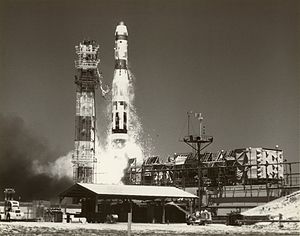- Cape Canaveral Air Force Station Launch Complex 16
-
Launch Complex 16 
Titan I launch from LC-16Launch site Cape Canaveral Air Force Station Location 28°30′06″N 80°33′06″W / 28.5017°N 80.5518°W Short name LC-16 Operator US Air Force Total launches 141 Launch pad(s) One Launch history Status Inactive First launch 12 December 1959 Last launch 21 March 1988 Associated rockets Titan I
Titan II
MGM-31 PershingLaunch Complex 16 (LC-16) at Cape Canaveral Air Force Station, Florida is a launch complex built for use by LGM-25 Titan missiles, and later used for NASA operations before being transferred back to the US military and used for tests of MGM-31 Pershing missiles. Six Titan I missiles were launched from the complex between December 1959 and May 1960. These were followed by seven Titan II missiles, starting with the type's maiden flight on 16 March 1962. The last Titan II launch from LC-16 was conducted on 29 May 1963.
Following the end of its involvement with the Titan missile, LC-16 was transferred to NASA, which used it for Gemini crew processing, and static firing tests of the Apollo Service Module's propulsion engine. Following its return to the US Air Force in 1972, it was converted for use by the Pershing missile, which made its first flight from the complex on 7 May 1974. Seventy nine Pershing IA and 49 Pershing II missiles were launched from LC-16. The last Pershing launch from the facility was conducted on 21 March 1988. It was deactivated the next day and subsequently decommissioned under the Intermediate Nuclear Forces treaty.
References
- Wade, Mark. "Cape Canaveral LC16". Encyclopedia Astronautica. http://www.astronautix.com/sites/capllc16.htm. Retrieved 2009-04-23.
Cape Canaveral and Merritt Island launch sites Atlantic Missile Range drop zone • Grand Turk Island drop zone • Mobile Launch Area • SLBM Launch Area • Patrick AFB • Shuttle Landing Facility • Cape Canaveral AFS Skid StripCategories:- Rocketry stubs
- Cape Canaveral Air Force Station
Wikimedia Foundation. 2010.
